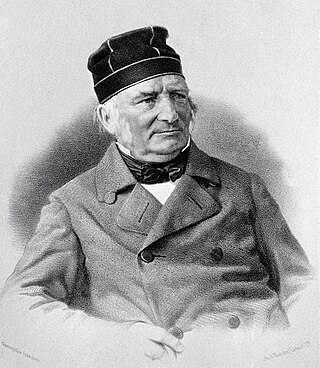Related Research Articles

Gaspard-Gustave de Coriolis was a French mathematician, mechanical engineer and scientist. He is best known for his work on the supplementary forces that are detected in a rotating frame of reference, leading to the Coriolis effect. He was the first to apply the term travail for the transfer of energy by a force acting through a distance.

The Silurian is a geologic period and system spanning 24.6 million years from the end of the Ordovician Period, at 443.8 million years ago (Mya), to the beginning of the Devonian Period, 419.2 Mya. The Silurian is the shortest period of the Paleozoic Era. As with other geologic periods, the rock beds that define the period's start and end are well identified, but the exact dates are uncertain by a few million years. The base of the Silurian is set at a series of major Ordovician–Silurian extinction events when up to 60% of marine genera were wiped out.

Lambert Adolphe Jacques Quetelet FRSF or FRSE was a Belgian astronomer, mathematician, statistician and sociologist who founded and directed the Brussels Observatory and was influential in introducing statistical methods to the social sciences. His name is sometimes spelled with an accent as Quételet.

Friedrich Georg Wilhelm von Struve was a Baltic German astronomer and geodesist from the famous Struve family. He is best known for studying double stars and for initiating a triangulation survey later named Struve Geodetic Arc in his honor.

Sir Roderick Impey Murchison, 1st Baronet, was a Scottish geologist who served as director-general of the British Geological Survey from 1855 until his death in 1871. He is noted for investigating and describing the Silurian, Devonian and Permian systems.
The year 1840 in science and technology involved some significant events, listed below.
The year 1811 in science and technology involved some significant events, listed below.
The year 1792 in science and technology involved some significant events.
The year 1796 in science and technology involved some significant events.
The year 1776 in science and technology involved some significant events.
The year 1871 in science and technology involved some significant events, listed below.
The year 1797 in science and technology involved some significant events.
The year 1800 in science and technology included many significant events.
The year 1801 in science and technology involved some significant events, listed below.
The year 1786 in science and technology involved some significant events.
The year 1783 in science and technology involved some significant events:
The International Meteorological Organization was the first organization formed with the purpose of exchanging weather information among the countries of the world. It came into existence from the realization that weather systems move across country boundaries; and that knowledge of pressure, temperature, precipitations, etc. upstream and downstream is needed for weather forecasting. It was superseded by the World Meteorological Organization.
Events from the year 1835 in the United Kingdom.

The planet Neptune was mathematically predicted before it was directly observed. With a prediction by Urbain Le Verrier, telescopic observations confirming the existence of a major planet were made on the night of September 23–24, 1846, at the Berlin Observatory, by astronomer Johann Gottfried Galle, working from Le Verrier's calculations. It was a sensational moment of 19th-century science, and dramatic confirmation of Newtonian gravitational theory. In François Arago's apt phrase, Le Verrier had discovered a planet "with the point of his pen".
Social physics or sociophysics is a field of science which uses mathematical tools inspired by physics to understand the behavior of human crowds. In a modern commercial use, it can also refer to the analysis of social phenomena with big data.
References
- ↑ Karl Mägdefrau (1994), "Mohl, Hugo von", Neue Deutsche Biographie (in German), vol. 17, Berlin: Duncker & Humblot, pp. 690–691; ( full text online )
- ↑ Murchison, R. I. (1835). "On the Silurian System of rocks". The London and Edinburgh Philosophical Magazine and Journal of Science. 7: 46–52.
- ↑ Murchison, R. I.; Sedgwick, A. (1835). "On the Silurian and Cambrian Systems". Report of the Meeting of the British Association for the Advancement of Science: 59–61.
- ↑ Crilly, Tony (2007). 50 Mathematical Ideas you really need to know. London: Quercus. p. 141. ISBN 978-1-84724-008-8.
- ↑ Airy, G. B. (1835) "On the Diffraction of an Object-glass with Circular Aperture". Transactions of the Cambridge Philosophical Society 5: 283–291.
- ↑ Mathew Graves at Who Named It?
- ↑ Graves, R. J. (1835). "New observed affection of the thyroid gland in females" (Clinical lectures). London Medical and Surgical Journal (Renshaw) 7: 516–517. Repr. in Medical Classics (1940) 5: 33–36.
- ↑ Morabia, Alfredo (March 2006). "Pierre-Charles-Alexandre Louis and the evaluation of bloodletting". Journal of the Royal Society of Medicine . 99 (3): 158–160. doi:10.1177/014107680609900322. PMC 1383766 . PMID 16508057.
- ↑ Eiseley, Loren (1961). Darwin's Century . Anchor Books (Doubleday). p. 227.
- ↑ Robertson, Patrick (1974). The Shell Book of Firsts. London: Ebury Press. pp. 127–8. ISBN 0-7181-1279-2.
- ↑ Vienna Symphonic Library > Vienna Academy > Brass > Tubas > Bass tuba > History.
- ↑ "The electromechanical relay of Joseph Henry". Georgi Dalakov. Retrieved 2013-10-03.
- ↑ "Copley Medal | British scientific award". Encyclopedia Britannica. Retrieved 22 July 2020.